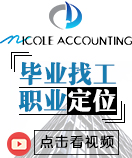Excel VBA 课程的功能很强大,用途非常广泛。对复杂数据的管理和操作 同时自动化创建不同的报表,Excel VBA不但可以提高快速提高工作效率同时也能简化你的日常工作。VBA已经成为会计人士必备的工作技能,同时也是你求职加薪的法宝,同时也让你在强手如林的面试中打败其他面试者,在面试中瞬间脱引而出。 越来越多的求职者都告诉我们在面试中问到是否懂VBA的操作。VBA将会成为衡量你职场竞争力和面试的一个重要筹码之一。Nicole 会计培训 Excel VBA 课程可以助你一臂之力
Nicole Accounting的Excel实战 高级班,由在财富500强上市公司Senior Business Analyst 工作 10 多年的资深会计师亲自授课, 比较适合学员已经学过Excel实战精英班 (http://www.nicoleaccounting.com.au/class.php?id=45), 想瞬间提高自己excel工作效率的同学。教学会包括复杂公式以及数据量大的excel spreadsheet 和 Design。掌握好这些技巧以及excel功能,绝对能在工作面试时对excel充满自信,以及给工作提高效率, 同时是升职加薪的法宝。
课程设置:
我们的高级班课程精心准备10个VBA应用于工作的实际案例,手把手地教会每个学员运用课程中学到的实战来解决实际工作问题,快速提高工作效率 ,涵盖大部分工作中会用到的excel 功能。采取小班教课,并且会布置课后作业。
本课程2 sessions, 授课时间;8小时, 免费重听8 小时, 包教包会
超高性价比: 原价只需$595.00. 特价优惠 $149 优惠截止日期 31/12/2016
VBA Course Outline
Introductions
· Introducing Visual Basic for Applications
· Enable the Developer Tab in the Ribbon
· Enable macros in Excel workbook and understand macro security
· Saving a Macro-Enabled Workbook
· How to run a Macro in different ways
· Editing a Macro in the Visual Basic code window
· Closing the Visual Basic Editor
Work with Expressions & Variables
· Understanding Expressions and Statements
· Declaring Variables
· Understanding Data Types
· Working with Variable Scope
· Using Message Boxes
· Using Input Boxes
· Declaring and Using Object Variables
Understand Procedures and Functions
· Understanding Modules
· Creating a Standard Module
· Understanding sub Procedures
· Public sub vs. private sub
· Creating a Sub Procedure
· Calling Procedures
· Creating a Function Procedure
· Naming Procedures
Understanding Objects
· Understanding workbook objects
· Extract workbook name, workbook full path
· Workbook method - open, save, close
· Understanding worksheet objects
· Worksheet name, worksheets count, rows & columns count
· Worksheet method – activate, add, delete, copy
· Range object – format, calculate, select, copy, paste
· Working with object property window
Understanding Event
· Workbook Open Event
· Worksheet Activate Event
· Worksheet Selection Change Event
· VBA Controls Event
· Application Event
Program Execution
· Using the If...End If Structures
· Using the Select Case...End Select Structure
· Using the Do...Loop Structure
· Using the For...To...Next Structure
· Using the For Each...Next Structure
Working with Forms and Controls
· Understanding UserForms, Setting Control Properties in the Properties Window
· Working with the Check Box Control
· Working with the Text Box Control
· Working with the Command Button Control
· Working with the Combo Box Control
· Working with Option Button Controls
· Adding Code to Controls and design report
Working with the PivotTable Object
· Understanding PivotTables
· Creating a PivotTable Using Worksheet Data
· Working with the PivotTable Objects
· Working with the PivotFields Collection
· PivotTable Related Event
Working with Images and Charts
· Understanding Image and Charts
· Working with Chart Properties windows
· Pictures copy, paste, delete
· Show image and hide image
· Show Charts and hide charts
VBA Tips:
· Assign Macros to Quick Access Toolbar
· Use shortcuts to run macro, open VBA editor window and return to Excel window
· Always activate target worksheet when workbook opens
· Permanently hide worksheets
· Make your macros work anywhere - Enabling Relative References
· How to customise ActiveX component
By the end of this course participants should be able to:
· Work with the VBA editor
· Understand VBA concepts and features
· Enable or disable VBA macros
· Create procedures and sub routines
· Record macros using macro recording and customise the VBA code
· Assign macros to object and shortcut to start macros in different ways
· Work with variables and Excel objects
· Work with different events (workbook, worksheet, controls, application)
· Use named range in VBA coding (highly recommended)
· Create user defined functions (such as user defined lookup functions to replace Vlookup)
· Create custom forms and design report
· Work with time & date, manipulate text string
· Handle errors and resume next
This Microsoft Excel VBA training course is designed for someone who wishes to peruse a career as management accountant, financial analyst or business analyst & data analyst, users who want to learn how to use the inbuilt programming language in Microsoft Excel to enhance their worksheets and automate processes.
You should have intermediate Excel Skills; know how to use Excel formulas such as Vlookup, Sumifs, PivotTable and basic charting etc. Programming language skills is not compulsory in the training.
After you have learnt this course, you should be able to write VBA macros to build applications and automate your daily task so you can work much faster, you will know how to create dynamic chart to visualise the data using different VBA controls and build complicated dashboard for different purpose such as KPIs analysis, Sales Performance, Budget Analysis etc. The possibilities are endless.




